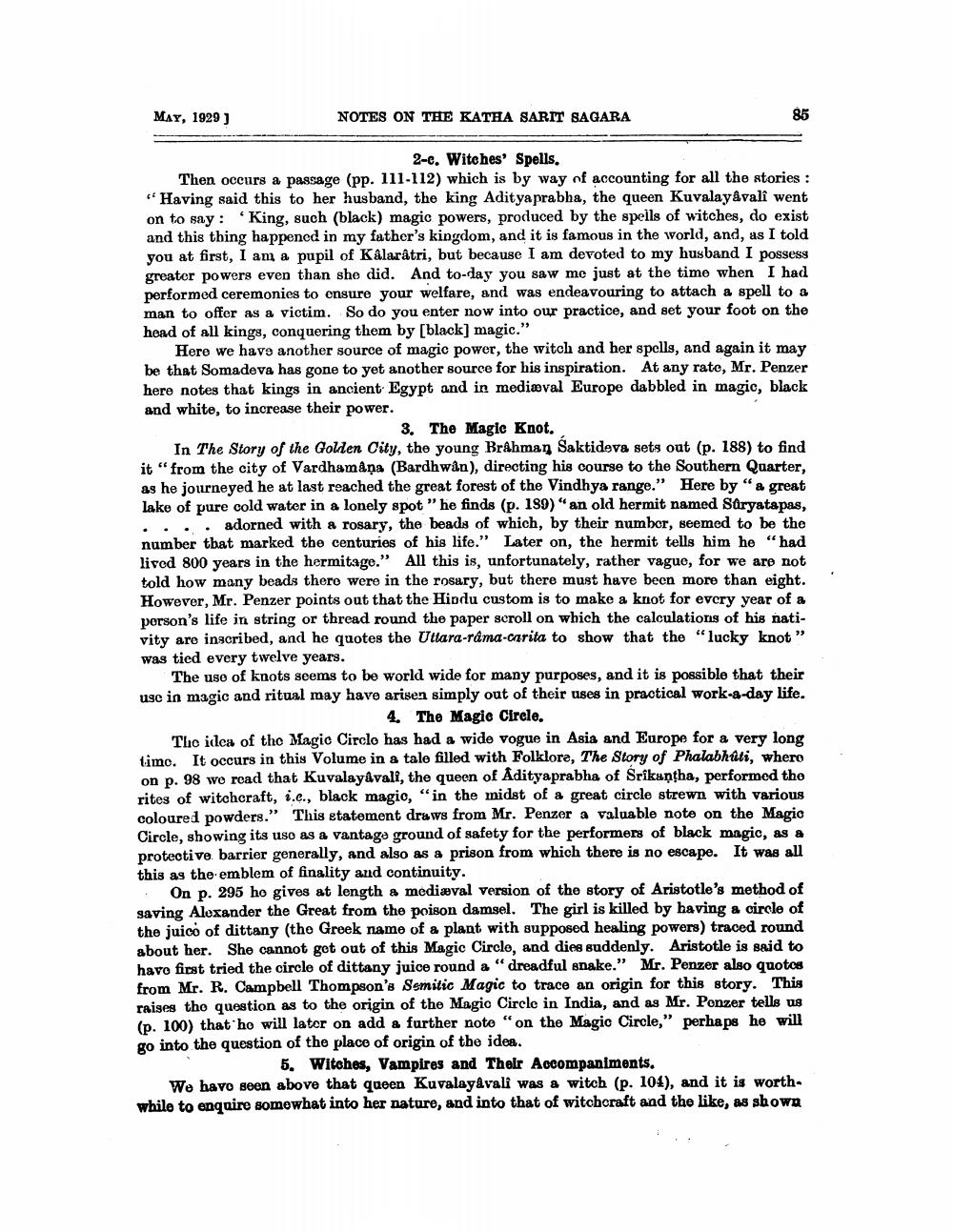________________
MAY, 1929 )
NOTES ON THE KATHA SARIT SAGARA
85
2-e. Witches' Spells. Then occurs a passage (pp. 111-112) which is by way of accounting for all the stories : "Having said this to her husband, the king Aditya prabha, the queen Kuvalayavall went on to say: 'King, such (black) magic powers, produced by the spells of witches, do exist and this thing happened in my father's kingdom, and it is famous in the world, and, as I told you at first, I am a pupil of Kålarâtri, but because I am devoted to my husband I possess greater powers even than she did. And to-day you saw me just at the time when I had performed ceremonies to ensure your welfare, and was endeavouring to attach a spell to & man to offer as a victim. So do you enter now into our practice, and set your foot on the head of all kings, conquering them by [black] magic."
Here we have another source of magic power, the witch and her spells, and again it may be that Somadeva has gone to yet another source for his inspiration. At any rate, Mr. Penzer here notes that kings in ancient Egypt and in mediæval Europe dabbled in magic, black and white, to increase their power.
3. The Magie Knot. In The Story of the Golden City, the young Brâhman Saktideva sets out (p. 188) to find it from the city of Vardhamana (Bardhwan), directing his course to the Southern Quarter, as he journeyed he at last reached the great forest of the Vindhya range." Here by “a great lake of pure cold water in a lonely spot " he finds (p. 189)" an old hermit named Saryatapas, .... adorned with a rosary, the beads of which, by their number, seemed to be the number that marked the centuries of his life." Later on, the hermit tells him he "had lisod 800 years in the hermitage." All this is, unfortunately, rather vaguo, for we are not told how many beads there were in the rosary, but there must have been more than eight. However, Mr. Penzer points out that the Hindu custom is to make a knot for every year of a person's life in string or thread round the paper scroll on which the calculations of his nativity are inscribed, and he quotes the Uttara-rama-carita to show that the "lucky knot" was tied every twelve years.
The use of knots seems to be world wide for many purposes, and it is possible that their usc in magic and ritual may have arisen simply out of their uses in practical work-a-day life.
4. The Magic Cirele. The idea of the Magic Circle has had a wide vogue in Asia and Europe for a very long time. It occurs in this Volume in a tale filled with Folklore, The Story of Phalabhaili, whero on p. 98 we read that Kuvalayâvali, the queen of Adityaprabha of Srikantha, performed the rites of witchcraft, i.e., black magic, “in the midst of a great circle strewn with various coloured powders.” This statement draws from Mr. Penzer a valuable note on the Magic Circle, showing its uso as a vantage ground of safety for the performers of black magic, as a protective barrier generally, and also as a prison from which there is no escape. It was all this as the emblem of finality and continuity.
On p. 295 ho gives at length a mediæval version of the story of Aristotle's method of saving Aloxander the Great from the poison damsel. The girl is killed by having a circle of the juico of dittany (the Greek name of a plant with supposed healing powers) traced round about her. She cannot get out of this Magic Circle, and dies suddenly. Aristotle is said to have first tried the circle of dittany juice round a "dreadful snake." Mr. Penzer also quotes from Mr. R. Campbell Thompson's Semitic Magic to trace an origin for this story. This raises tho question as to the origin of the Magic Circle in India, and as Mr. Ponzer tells us (p. 100) that'ho will lator on add a further note "on the Magic Circle," perhaps he will go into the question of the place of origin of the idea.
5. Witches, Vampires and Their Accompaniments. We havo seen above that queen Kuvalayávali was a witch (p. 104), and it is worthwhile to enquire somewhat into her nature, and into that of witchcraft and the like, as shown




